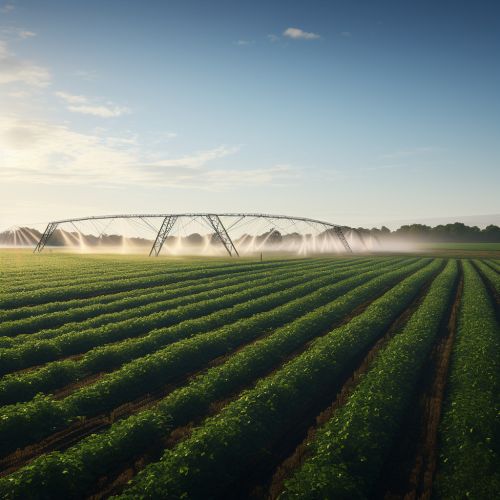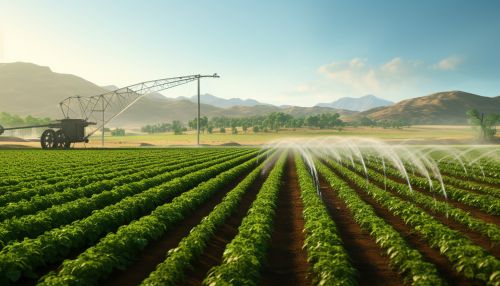Irrigation Management
Introduction
Irrigation management refers to the systematic process of water application in a controlled manner for assisting in the production of crops. This process involves various strategies and activities including, but not limited to, determining water sources, selecting appropriate irrigation systems, scheduling irrigation, and maintaining the irrigation system. The goal of irrigation management is to use water in the most efficient and sustainable way, while maximizing crop yield and quality.


History of Irrigation
The practice of irrigation dates back to ancient times, with evidence of irrigation systems in ancient Egypt and Mesopotamia. These early systems relied on simple technology, such as canals and ditches, to divert water from rivers and streams to agricultural fields. Over time, irrigation practices have evolved, with advancements in technology and understanding of water and soil science leading to more efficient and sustainable irrigation systems.
Types of Irrigation Systems
There are several types of irrigation systems, each with its own advantages and disadvantages. These include surface irrigation, drip irrigation, sprinkler irrigation, and sub-irrigation.
Surface Irrigation
Surface irrigation is the oldest form of irrigation and involves the application of water directly to the soil surface. This method is often used in flat, level fields and relies on gravity to distribute the water. While surface irrigation is relatively inexpensive and simple to implement, it can be less efficient than other methods due to evaporation and runoff.
Drip Irrigation
Drip irrigation, also known as trickle irrigation, involves the slow application of water directly to the root zone of plants. This method is highly efficient as it minimizes evaporation and runoff. However, drip irrigation systems can be more expensive and complex to install and maintain.
Sprinkler Irrigation
Sprinkler irrigation is a method that simulates natural rainfall by distributing water through a system of pipes and sprinklers. This method can be highly efficient and allows for the uniform distribution of water. However, sprinkler systems can be more expensive to install and operate, and may not be suitable for all types of crops or soil conditions.
Sub-Irrigation
Sub-irrigation involves the application of water below the soil surface, either by raising the water table or by using a system of pipes to deliver water directly to the root zone. This method can be highly efficient and allows for precise control over water application. However, sub-irrigation systems can be complex and expensive to install and maintain.
Irrigation Scheduling
Irrigation scheduling is a critical aspect of irrigation management. It involves determining when to irrigate and how much water to apply, based on factors such as soil type, crop needs, weather conditions, and water availability. Proper irrigation scheduling can help to maximize crop yield and quality, while minimizing water use and preventing waterlogging or salinization of the soil.
Irrigation Efficiency
Irrigation efficiency refers to the ratio of the amount of water used by the crop to the total amount of water applied through irrigation. Factors that can affect irrigation efficiency include the type of irrigation system used, the timing and amount of irrigation, and the management of the irrigation system. Improving irrigation efficiency can help to conserve water resources, reduce costs, and improve crop yield and quality.
Challenges in Irrigation Management
There are several challenges in irrigation management, including water scarcity, climate change, and environmental impacts.
Water Scarcity
Water scarcity is a major challenge for irrigation management. With increasing demand for water resources from various sectors, there is a need for more efficient and sustainable use of water in agriculture. This requires innovative approaches and technologies in irrigation management.
Climate Change
Climate change poses significant challenges for irrigation management. Changes in temperature and precipitation patterns can affect water availability and demand, as well as crop growth and productivity. This requires adaptive strategies and practices in irrigation management to ensure food security under changing climate conditions.
Environmental Impacts
Irrigation can have significant environmental impacts, including waterlogging, salinization, and degradation of aquatic ecosystems. These impacts can be minimized through proper irrigation management, including the use of efficient irrigation systems, appropriate irrigation scheduling, and the implementation of best management practices.
Conclusion
Irrigation management is a complex and critical aspect of agriculture. It involves a range of practices and strategies aimed at maximizing crop yield and quality, while minimizing water use and environmental impacts. With increasing challenges such as water scarcity and climate change, there is a need for continuous innovation and improvement in irrigation management practices.
